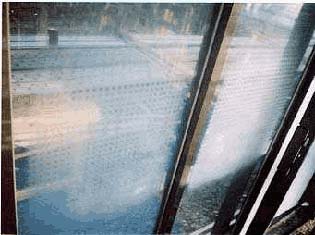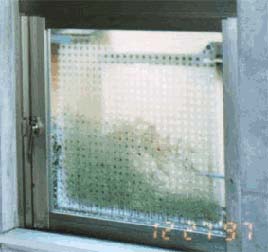The picture on the left was taken at a construction
site on April 8, 2000.
A person in charge of the construction reported
us that he could see dew condensation
where
no one living yet.
He claimed it to us, as he was told of the
SPACIA would hardly
condense dew.
The location is Kumanogawa town of Wakayama
Prefecture, a warm
area in the southern part of the Kii peninsula.
Probably a very humid air from the ocean blew onto the glass, but warm air was trapped in
the room by the SPACIA. No one was living at that time, as it was under construction.
Once very humid air meets with a cold object whose temperature is lower than the air itself,
it disgorges the moisture as dew condensation.
It was assumed that the glass was kept at a low temperature from the previous night.
A warm air in the room conducted through the spacers to outside of the glass,
and around the spacers was transparent.
Leaking of the inner temperature is only through the micro-spacers.
The frame of sliding door made of aluminum directly conducts inner room temperature to outside,
therefore, dew condensation does not occur.
This proves Spacia's high insulation function.

